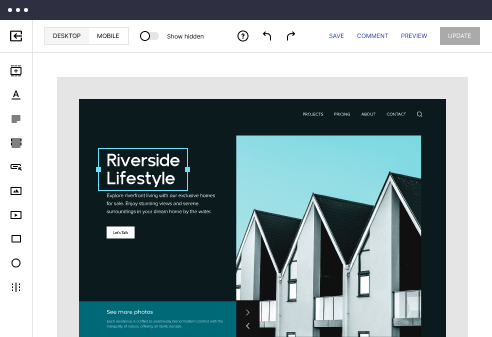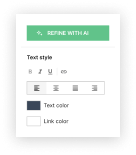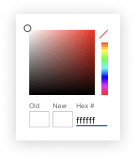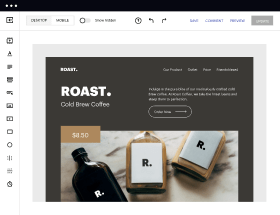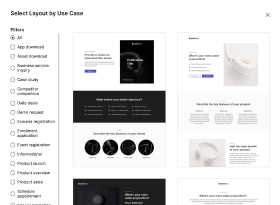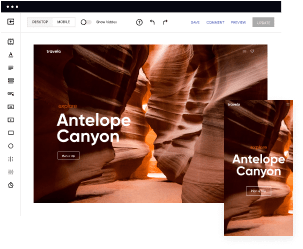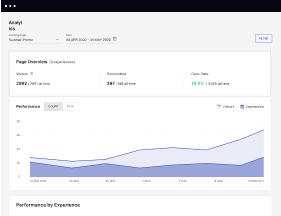Get a starting point with the React.js optimized categories page template
Supercharge your categories page with React.js for outstanding performance! Learn more today.

Easy to build without coding
With the intuitive drag-and-drop builder, anyone on your team can create high-converting pages without any knowledge of code or design. Make enhancements to your landing page with custom widgets using Javascript, HTML/CSS, or third-party scripts.
Multiple layouts for any industry and goal
Select from 500+ landing page layouts built to boost conversions across industry-specific scenarios. Customize them by adjusting fonts, adding images, and generating on-brand content with the AI assistant. Quickly scale with Instablocks® and Global Blocks that you can save, reuse, and update globally.
Loads fast and looks polished on any device
Every template is responsive, which means they present professionally on any device and load blazingly fast with our Thor Render Engine. You can also power them up with Google AMP technology to deliver an unparalleled mobile experience and drive higher conversions.
Robust analytics & experimentation
Get real-time updates and reporting across all your devices, showing the number of visitors, conversions, cost-per-visitor, and cost-per-lead. Launch AI-powered experiments, run A/B tests, and use heatmaps to analyze user behavior, then optimize your landing page to maximize conversions.
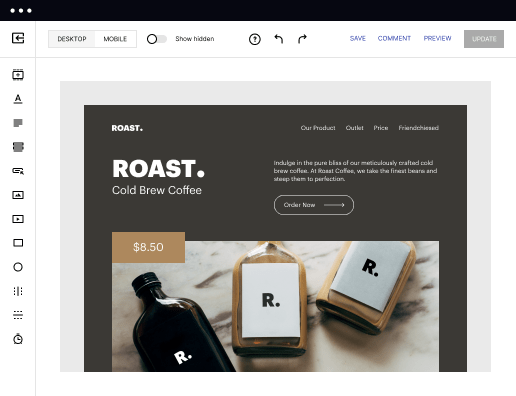
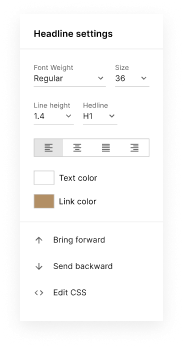
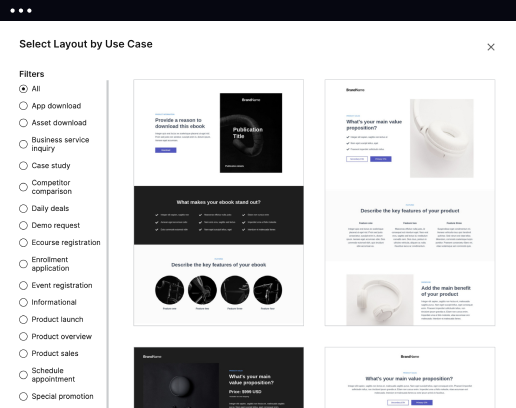
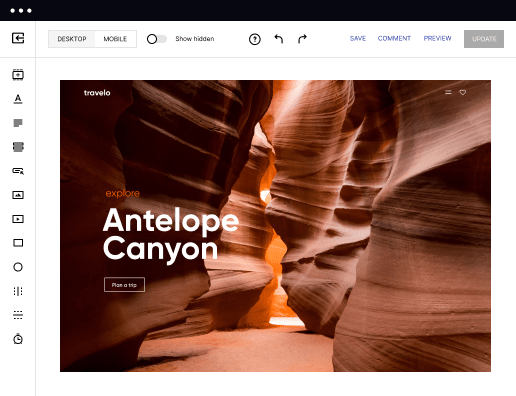
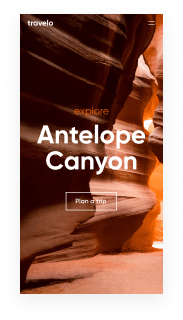
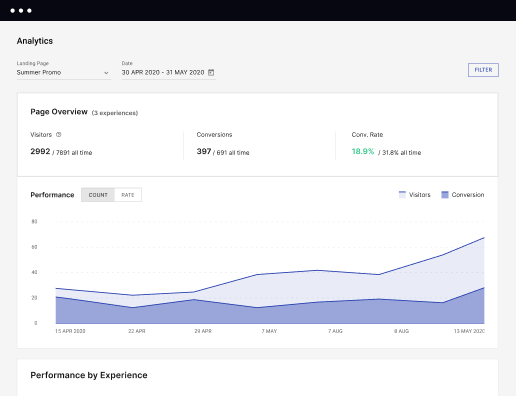
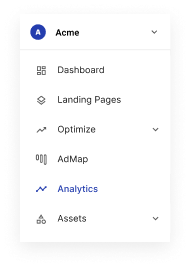
Easy to build without coding
With the intuitive drag-and-drop builder, anyone on your team can create high-converting pages without any knowledge of code or design. Make enhancements to your landing page with custom widgets using Javascript, HTML/CSS, or third-party scripts.
Multiple layouts for any industry and goal
Select from 500+ landing page layouts built to boost conversions across industry-specific scenarios. Customize them by adjusting fonts, adding images, and generating on-brand content with the AI assistant. Quickly scale with Instablocks® and Global Blocks that you can save, reuse, and update globally.
Loads fast and looks polished on any device
Every template is responsive, which means they present professionally on any device and load blazingly fast with our Thor Render Engine. You can also power them up with Google AMP technology to deliver an unparalleled mobile experience and drive higher conversions.
Robust analytics & experimentation
Get real-time updates and reporting across all your devices, showing the number of visitors, conversions, cost-per-visitor, and cost-per-lead. Launch AI-powered experiments, run A/B tests, and use heatmaps to analyze user behavior, then optimize your landing page to maximize conversions.
All the features you need to build lead-generating landing pages
Explore more featuresLearn how to build top-performing landing pages for any goal
FAQs
Leading the way in building high-performing landing pages





Transform Your Marketing with Instapage: The Ultimate Landing Page and CRO Platform
Instapage stands out as the premier platform for creating high-converting landing pages that maximize the ROI of your digital marketing initiatives. Marketers across various sectors, including tech, finance, and education, can leverage Instapage's robust features to ensure their campaigns are not only designed efficiently but also optimized for performance.
Optimize Your Campaigns with Powerful Tools
The first step in achieving success with your marketing campaigns is understanding how to utilize Instapage's capabilities. By employing over 100 ready-to-use templates and lead generation elements, marketers can quickly launch pages. Instapage’s flexible design ensures that even users without coding knowledge can create attractive, conversion-focused landing pages tailored to their audience's needs.
- Templates: Choose from a variety of ready-to-use templates that have proven effectiveness.
- Intuitive Builder: Create pages effortlessly with drag-and-drop functionalities, ensuring every element is positioned for maximum impact.
- Lead Gen Elements: Incorporate powerful lead generation tools designed to enhance your conversion rates.
Leverage A/B Testing to Drive Improvements
Optimizing your landing page isn't just about design; it's also about continuous testing and adjustments. Instapage provides built-in experimentation features, including detailed heatmaps and A/B testing tools, to analyze user behavior efficiently.
- Heatmaps: Visualize where users click most often on your pages, guiding layout improvements.
- A/B Testing: Compare different page versions to determine which performs better in real-time.
- Performance Analytics: Track metrics that matter, enabling you to refine your strategy quickly.
Personalize Experiences for Higher Engagement
Personalization is a crucial aspect of effective marketing. Instapage allows for dynamic text replacement and other features ensuring that your messaging resonates with each unique audience segment.
- Dynamic Text Replacement: Instantly modify content based on user characteristics, improving relevance.
- Ad Mapping: Align ads to specific landing pages to ensure seamless user experiences.
- Audience Tracking: Utilize sophisticated data tools for insights into how different segments interact with your content.
By employing these strategies, marketers can enhance their effectiveness and foster trust among their audience, making Instapage a valuable asset in their toolset.
With Instapage, marketers will not only create visually pleasing landing pages but also implement smarter strategies, optimizing their conversion rates continually.
Ready to take your digital marketing campaigns to the next level? Explore the capabilities of Instapage today and experience a transformation in your campaign’s effectiveness!
The evolution of digital experiences: unpacking the ReactJS optimized categories page template
The significance of pages in modern web applications
In any modern web application, the categories page serves as a critical pivot for users exploring various products or services. It not only simplifies navigation but also plays a pivotal role in funneling users towards conversion paths. With countless offerings available, the categories page acts as a roadmap that guides visitors toward items that meet their needs. Ensuring that this experience is seamless amplifies user satisfaction and interaction on the website.
When crafted thoughtfully, well-designed templates can significantly enhance both user experience and engagement metrics. Responsiveness ensures that users can navigate effortlessly on mobile and desktop devices alike. Accessibility is equally paramount; ensuring that all individuals, regardless of physical ability, can interact with the site empowers brands to expand their reach. Additionally, optimizing categories pages for search engines through clear structure and organization enhances visibility, helping to attract more organic traffic.
Introducing ReactJS: a framework for modern development
ReactJS has gained significant traction among developers as a preferred framework for building dynamic user interfaces. Its component-driven architecture allows developers to create reusable components that can drastically reduce development time and effort. This modularity not only simplifies maintenance but also facilitates collaboration among teams. With a component library, developers can easily create a cohesive look across the application while ensuring updates happen swiftly and without interrupting user experiences.
One of the standout features of ReactJS is the virtual DOM, which optimizes UI rendering and enhances application speed. By maintaining a virtual representation in memory, React allows for efficient updating of the actual DOM only when necessary. This results in top-tier performance that is crucial for retaining users' attention in fast-paced digital environments. Moreover, one-way data binding provides developers control over the flow of data, reinforcing predictable and stable user interfaces.
Core components of an optimized categories page template
To craft a successful categories page using ReactJS, it is essential to break down the page's components systematically. Primary elements should include a navigation bar that allows users to browse categories effortlessly. Implementing filter and sort functionalities will enable users to refine their choices, ensuring they can make quick decisions based on their preferences. Product card displays need to be visually appealing, showcasing important details like images, descriptions, and prices while maintaining a clean layout.
Furthermore, pagination or infinite scrolling features are vital in managing product visibility without overwhelming users. A well-structured layout not only improves aesthetics but also makes user interactions satisfying. By leveraging React's component structure, developers can create reusable elements that allow for dynamic rendering based on changes in application state or passed props. This adaptability offers tailored experiences that can significantly enhance user satisfaction.
Crafting a high-performance categories page: best practices
To retain users and lower bounce rates, loading speed must be prioritized in any categories page design. Implementing lazy loading techniques can greatly benefit performance by only loading images and components when they come into view. This practice not only results in faster initial load times but also conserves bandwidth, particularly for mobile users who may be on limited data plans. Additionally, using caching strategies can significantly reduce the loading time for returning users, subsequently enhancing the overall user experience.
As product ranges grow, scalability becomes essential. Structuring the React components wisely allows for straightforward expansion without major redesigns. An approach that involves encapsulating logic specific to each component sets the stage for efficient management and expansion. Furthermore, employing effective state management solutions, such as Redux or Context API, ensures that complex data interactions remain smooth and clear, especially for larger applications.
Enhancing user experience with innovative features
Increasing user engagement on categories pages can be achieved through innovative interactive elements. Integrating animations such as subtle transitions can reinvigorate a static interface, making it feel livelier and more intuitive. Additionally, implementing real-time filtering and searching capability will allow users to find what they’re looking for without lengthy navigation processes. Such features can significantly enhance user satisfaction and encourage them to spend more time on the page.
Alongside engagement, accessibility is crucial to ensure all users can interact with the website effortlessly. Adherence to WCAG standards guarantees that powerful technologies, including screen readers, can interpret the content and enhance the browsing experience for users with disabilities. Techniques such as providing alternative text for images, keyboard navigability, and proper color contrasts can make an enormous difference in reach and usability.
The role of offer and promotion in categories pages
In the competitive landscape of online shopping, crafting irresistible offers directly impacts user decisions. Displaying limited-time promotions using eye-catching banners can create a sense of urgency, prompting quick purchases. Moreover, regularly highlighting sale items ensures that users are aware of potential savings, which can be crucial in influencing their browsing behavior. Creating distinct sections for promotions within a category can also facilitate easy discovery, enhancing the overall shopping experience.
Incorporating discounts involves employing React components that can manage state effectively with user interactions. For example, using hooks to update price displays dynamically when users interact with promotional overlays can create a more engaging shopping scenario. Coupled with engaging design, these elements transform basic browsing into a delightful experience that encourages conversions.
Harmonizing aesthetic and functional design
Finding the right balance between aesthetic appeal and functional design is critical for any categories page. Employing design systems yields a consistent look and feel, which is essential for brand identity and enhances user familiarity with the interface. Clean and unobtrusive layouts create the ideal environment for users to focus on products, while strategic use of whitespace can prevent overcrowding. Typography also plays a significant role; selecting appropriate fonts helps transmit the brand message while ensuring readability.
Keeping an eye on design trends is equally important; categories pages can vary from minimalist aesthetics to bold visuals. Designers should always aim to anticipate trends, as staying one step ahead can differentiate a product in a competitive market. Understanding the interplay between visual elements and user engagement allows brands to craft experiences that attract user interest and foster conversions.
Project setups: streamlining development process
Setting up the environment for React projects requires careful consideration of tools and libraries to facilitate a smooth development process. Choosing the right framework version, combined with essential libraries like React Router for navigation or Axios for API calls, can streamline the setup dramatically. Furthermore, leveraging version control systems such as Git ensures that collaborative coding efforts run seamlessly, minimizing conflicts and promoting agile development practices.
Select key libraries: Prioritize libraries that enhance the core functionality of the React project.
Utilize create-react-app: A boilerplate tool for quickly initializing new projects with an optimized configuration.
Implement testing tools: Utilize testing libraries such as Jest and React Testing Library for maintaining high-quality code.
To expedite development further, utilizing template libraries can be highly beneficial. Pre-built templates can save time and enable customization while providing a solid foundation from which to develop unique solutions. Highlighting valuable React template resources can empower developers to kickstart their projects efficiently while ensuring reliability and adaptability.
Case studies: successful implementations in real-world projects
Several industry leaders have adopted optimized categories page templates built with ReactJS, showcasing effective strategies in their designs. E-commerce giants, for example, utilize advanced filters and search functionalities that allow users to navigate extensive product ranges without feeling overwhelmed. Their designs not only promote featured products but also foster user exploration through related items, significantly increasing dwell time and potential conversions.
Conversely, small businesses leverage similar optimized templates to streamline their offerings and compete efficiently within niche markets. By tailoring categories page experiences to their specific customer base, they create appealing entry points that drive sales and foster brand loyalty. Ultimately, measuring outcomes through analytics reveals direct success correlated with enhanced engagement rates and conversion metrics, validating the effectiveness of these strategies.
The future of ReactJS categories page templates
As technology evolves, several emerging trends are anticipated to redefine categories page templates. Headless CMS integration is one innovation that offers enhanced flexibility for content management and dynamic content delivery, allowing developers to decouple the front end from backend services. This shift enables rapid development and deployment cycles while maintaining performance.
Additionally, server-side rendering through tools like Next.js is gaining traction. This approach can offer superior SEO benefits, which is crucial for successful online engagement. Balancing innovation with functionality will remain paramount, as developers must perpetually adapt to shifting user expectations and preferences, ensuring that their creations remain relevant and user-focused at all times.
Developers' voices: insights and recommendations
Hearing from experienced developers can provide unparalleled insights into constructing optimized categories pages. Many experts recommend approaching development with a focus on modularity, emphasizing the importance of reusable components that allow developers to save time and reduce redundancy. By considering user feedback during the design process, developers can avoid common pitfalls such as inadequate performance or poorly structured interfaces.
New developers embarking on the journey of creating templates should prioritize mastering core concepts of React, alongside understanding state management. Resources abound, from community forums to comprehensive documentation, aiding individuals in their learning journey. Engaging with the community can yield invaluable advice, establishing connections that can provide support and foster collaborative improvement.
Conclusion: the impact of optimized categories pages
In conclusion, optimized categories pages hold significant value within the architecture of modern websites. Acting as essential gateways for users, they facilitate seamless navigation through diverse offerings while contributing to enhanced user satisfaction. The practices outlined throughout this article emphasize the approach developers can take to create high-performance templates that not only engage but also convert visitors.
Looking toward the future, it is vital to stay attuned to ongoing innovations and shifts in consumer behavior. By continuously adapting design strategies and honing development practices, teams can create compelling experiences that resonate with users. Ultimately, encouraging a culture of exploration and openness will strengthen the overall development community and lead to the creation of even more exceptional user experiences.
Ready to skyrocket conversions?
Supercharge your ad campaigns with high-performing landing pages
Get started